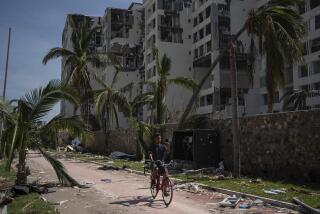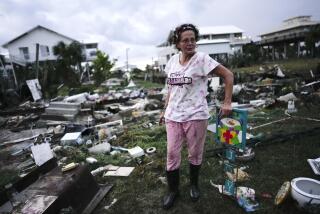Florida’s ordeal
Hurricane Frances crawled across the Florida peninsula Sunday, leaving a record 5 million people in the state without power, damaging homes, flooding roadways and prompting the governor to divert gasoline supplies to rescue agencies.
Florida’s second major hurricane in three weeks was slower and less destructive than anticipated, but it made up in sheer breadth of impact what it lacked in deadly depth, touching nearly every county from Key West to Jacksonville.
“It lasted so doggone long,” said Wayne Copley, 74, as he picked up what was left of what he called his “antique trash and treasures” in his Brevard County garage.
And it wasn’t over yet. The storm, downgraded to a tropical storm Sunday afternoon, is expected to regroup today in the Gulf of Mexico as a minimal hurricane and deliver more wind and rain, this time to the Panhandle and portions of Alabama and Georgia.
Frances was blamed for at least two deaths in Florida, both in the Gainesville area. A Lakeland man was killed when his car hit a tree and a woman in her 60s was killed in her living room when an oak tree crashed onto her mobile home Sunday. There were two earlier deaths in the Bahamas, where thousands were forced from their homes. Hurricane Charley was blamed for 27 deaths.
Frances set several records. It cut power to more residents than hurricanes Andrew and Charley combined and triggered the largest evacuation in state history with 2.8 million people ordered inland and more than 86,000 moving into 233 public shelters. A record force of 8,000 Red Cross volunteers and FEMA workers assembled to help in the aftermath.
Emergency workers ready
The storm caused widespread damage and disruption, particularly along the Atlantic Coast.
Winds toppled the steeples of the First Baptist Church of Cocoa Beach and the First Missionary Baptist Church of Yeehaw Junction in Osceola County. In the Daytona Beach area, the Halifax River overflowed and submerged a section of Beach Street. Across Central Florida, Frances peeled roofs, shattered trees and sent boats and power lines flying.
In Fort Pierce, about 15 miles from where Frances came ashore, a large steel railroad-crossing signal downtown was twisted like a corkscrew. Gas-station awnings sat on their sides blocking the pumps. Downtown streets were crisscrossed with toppled palm trees.
Along the waterfront, eight sail and fishing boats lay on their sides, broken apart in a row at the city’s marina. On nearby Hutchinson Island, the Royal Inn lost its entire roof, and a hole was punched on the side of the building.
Ramiro Venegas, an itinerant worker from Mexico, said the storm forced him to spend two nights sleeping in a men’s toilet at a Fort Pierce marina. He said he had been staying in his girlfriend’s car until she ditched him two days earlier.
“I’m thirsty, I’m hungry, and I’m soaking wet,” Venegas said.
The Army National Guard on Sunday was positioning troops near Lake Wales to assist with evacuations and debris removal.
“We’re not going to wait for blue skies to start to respond,” said State Emergency Management Director Craig Fugate. “We just need to wait until crews can be safe.”
Fuel shortages remain a problem, particularly with concerns that some residents may want to return home or travel too soon, officials said.
“Our biggest fear is, as in Hurricane Charley, more people died after the storm,” Fugate said.
To make sure that those in dire need get help, Gov. Jeb Bush said emergency managers across the state would have priority on diesel and gasoline until the supply lines from Port Everglades in Fort Lauderdale -- the state’s largest supplier of fuel -- resume normal operations.
Port Everglades reopened Sunday, and 50 emergency-service trucks began ferrying fuel to priority areas determined by state and federal emergency managers. Among their destinations was a Palm Beach County wastewater-treatment facility that needs diesel to operate.
“For the next day or two, the priority is to put all the supply-line activity to the relief effort,” Bush said. “We’re not rationing. We’re just allocating. We’re prioritizing, and once that’s established we go back to business as usual.”
He was not worried about Floridians hoarding gas, Bush said.
“If they are in an impacted area, they won’t be able to get gas because there is no electricity,” he said.
Hurricane Ivan
Hurricane Ivan, the ninth named storm of the season, is churning in the Central Atlantic, posing a potential threat to Florida.
Only half-joking Sunday, Gov. Bush threatened a $5 fine to anyone who mentioned Ivan. But the governor, who was touring damaged areas in Palm Beach County, later said of Ivan, “We’ll take it on. We’re a resilient state.”
Preliminary reports indicated Frances did not cause nearly the damage done by the smaller and swifter Charley, which raced up the spine of the state Aug. 13, causing an estimated $7.4 billion in insured losses.
Many battle-weary Central Floridians all but shrugged off a weekend of relentless winds, torrential rains and even exploding power lines.
“This is a walk in the park compared to last time,” said Steward Hall, as he removed branches from the sidewalk of his College Park home.
Orlando International Airport planned to reopen today as did most of the theme parks, except for Disney-MGM Studios and Animal Kingdom.
Frances was a Category 2 storm with 105 mph winds as it made landfall at Sewall’s Point, near Stuart, about 1 a.m., said state meteorologist Ben Nelson. It diminished further to a Category 1 hurricane with 95 mph winds as it moved across Central Florida. The eye of the hurricane passed about 50 miles south of Orlando.
Rainfalls were nearly half the predicted amounts in most areas but still reached 13 inches along the state’s central-east coast, causing flooding in some coastal and low-lying areas.
More looters
Northbound Interstate 95 was closed in Palm Beach County because of a washout. Officials also closed the Sunshine Skyway across Tampa Bay because of high winds.
In Martin County, 630 evacuees at a school were forced to another shelter when part of the roof blew off, flooding 16 rooms.
In Vero Beach, residents complained that they couldn’t find their swimming pools for all the water dumped by the storm.
Brian Theordor sloshed through about 3 feet of water Sunday inside his duplex and gathered the few items he could salvage: a TV and his fishing poles. When his home lost most of its roof during the storm, the 47-year-old mechanic nailed plastic trash bags to the ceiling and huddled with his black and white cat, Dice.
A commercial fisherman for 30 years, Theordor said the storm was “like a rough day at sea -- and I was inside my house.”
In south Brevard County, Barefoot Bay resident Casper Sammarcho joined about only 17 of his neighbors who rode out the storm in the sprawling manufactured home community of 15,000 residents.
Sammarcho admitted to having strong doubts about his decision during an 11-hour battering, especially when his kitchen counters began to vibrate and his neighbor’s carport took flight 50 feet in the air.
“This is the worst storm I’ve seen because it was so long,” said Sammarcho, 67. “I mean, it was really bad.”
The safety of Barefoot Bay residents, most of whom are retirees, was a major concern for officials, given its long history of being hit by hurricanes and tornadoes. But early reports indicate damage there was limited mostly to carports and decks.
Undeterred, looters showed up across the state in higher numbers than seen after Charley. About two dozen people were arrested across the state. “There’s more this time than during Charley because Charley came by so fast,” said Orange County Sheriff’s Chief Steve Jones. “There’s more opportunity for looting, but we’re rounding them up pretty fast.”
Within hours of Frances’ arrival, the big cleanup was already under way.
The rain and winds had yet to fully subside near her home in Vero Beach, but Leonor Tamulebloz, 62, was lifting heavy Australian pine branches in knee-deep water and dragging them to the side of the road to clear her driveway
“Wait for a crew?” she said. “I don’t think so.”
Maya Bell, Lisa Emmerich, Amy Rippel, Bob Mahlburg, Alicia Caldwell, Beth Kassab and Jason Garcia and of the Sentinel staff contributed to this report. Wire services also were used. Wes Smith can be reached at dwsmith@orlandosentinel.com or at 407-420-5672. Pamela J. Johnson can be reached at pjohnson@orlandosentinel or 407-420-5171.
More to Read
Start your day right
Sign up for Essential California for news, features and recommendations from the L.A. Times and beyond in your inbox six days a week.
You may occasionally receive promotional content from the Los Angeles Times.






